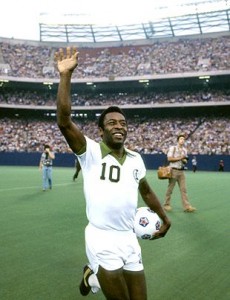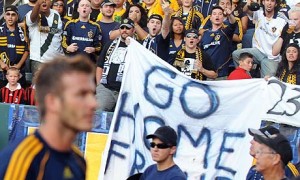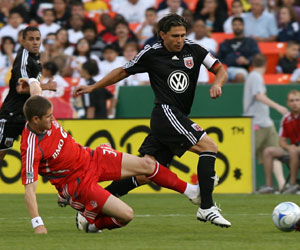Eight Ways To “Americanize” Soccer For American Fans

Most Americans only care about competitive soccer when it is time for the World Cup or Olympics. Would some minor "tweaks" make the game more appealing on a regular basis?
As Major League Soccer begins to wind down its season and Women’s Professional Soccer is two months beyond the end of their inaugural season, it is time to reflect on the status of soccer in the United States and do a little diagnosis and prognostication.
There are critics who assert that low scoring matches, ties, and no-scoring matches as outcomes that must be changed in order to save the American game. Some have suggested enlarging the dimensions of the goal, shrinking the size of the pitch, and shortening the length of the match, using PK’s as tie-breakers, and calling more penalties in the box as his key solutions. In other words, tweak the game in order to increase scoring, and to eliminate ties as final outcomes.
The basic premise of such arguments, that soccer is not consistent with American sports culture in key aspects is a good one. Beyond that, the sport’s critics mostly miss the mark.
Changing the physical dimensions of the pitch or the goal, or the length of the match would diminish whatever international credibility American soccer may have, and make it more difficult for American players to adapt to the international game.
It would also alienate American soccer purists (of which there are more than some critics might think) who make up the fan base of both leagues right now, and are essential to both leagues’ success.

Pele increased the visibility of soccer in the United States during the 1970s, but the interest in the professional game was short-lived.
It is also important to note that unlike most home-grown American sports, the act of scoring is not the key focus of the game, but even in American sports, there’s more to the game than scoring.
First of all, the first and most American of all home grown games—baseball—is slower and often as low scoring as soccer. The only difference is that games can’t end in ties. Given that some games go into 15 innings or more, it might actually improve the game if ties were allowed.
In American football, a well-managed drive to the red zone is something wonderful to watch and while a team’s failure to convert a red-zone possession into points on the board is frustrating, the game is no less exciting because the goal line wasn’t crossed.
If there are brilliant runs and beautiful passes as offenses move the chains, an eventual field goal or touchdown is icing on the cake. But even without the icing, the cake is very tasty. And from a defensive perspective, a goal line stand is almost as thrilling for fans as a touchdown.
In basketball, a powerful shot block is as incendiary to the fans, and as potentially momentum-shifting as a three-point shot.
In soccer, what happens between the goals is even more significant than basketball or football. Watching an attack begin to form and gather steam, watching plays continually re-shape to adapt to defensive stops, is as thrilling as it is visually beautiful.
A power shot that barely misses, stops hearts on both sides of the pitch.

Instead of trying to make a big splash by bringing in international soccer stars like David Beckham, soccer in the U.S. might be better served to make minor alterations to the game that make it more enticing for American fans.
A dramatic save often earns the applause of the opposing fans as well as the supporters, due to the difficulty of the stop and the beauty of the physical execution.
So in my opinion, it isn’t scoring or the lack of which that impairs the growth of American soccer. It is more subtle cultural idiosyncrasies that could be tweaked without destroying the integrity of the game.
In other words, we can Americanize soccer in ways that will raise international eyebrows but not evoke international disdain, and in ways that don’t make it harder for our National teams or our home grown players to succeed in international competition.
I will submit my own suggestions of rule and policy changes that would increase the marketability of the MLS and WPS in the United States and Canada without altering the fundamentals of the game.
First: Timekeeping
To maintain credibility with local soccer purists and especially with the international community the games must remain 90 minutes long. But…we can keep the official score on the scoreboard, and count down the time by period rather than counting up by entire game length.
Americans are used to getting the actual time on the score clock, and they’re used to counting down. This cosmetic change would do nothing to harm the integrity of soccer and would make American fans much more comfortable.
Second: Substitutions
We’d hear a little more noise from the purists about this one, but they’d get over it. I’d be in favor of allowing more than three substitutions and allowing players to re-enter the game after being subbed out. This, again, would make soccer more like the rest of our sports, and would ensure that legs remain fresh ’til the end.
Third: Team Names
Purists love it, but team names that include FC anything just don’t make sense to American fans. It would be up to individual franchises to evaluate whether or not to change such names as FC Dallas, Toronto FC, Sky Blue FC or FC Gold Pride but teams with names that can be personified by a mascot play better in America.
Fourth: Uniforms

Would Americans care more about soccer if the uniforms didn't make the players look like walking advertisements?
“American” sports have prominent team logos on their uniforms. The MLS and WPS should consider scrapping the international style uniform in which the only prominent graphics are commercial logos and in which the team insignia can’t be seen without binoculars.
I understand that corporate sponsorship is crucial to the financial survival of soccer in the US, but I would limit corporate signage to the lower back of the jersey, and make the team logo prominent on the front of the jersey, similar to the style of the original Chicago Fire uniforms.
Chicago had it right in the first place. More recently they have gone the wrong direction on this point.
Fifth: Tie Breakers
On this point I agree with Mark Jones. Americans like resolution. We’ve added tie-breakers to football and hockey, much to the betterment of both sports. A shoot out at the end of a deadlocked soccer match would add a great deal of drama, and hopefully a great deal more butts in the seats.
Sixth: More Liberal Use of PK’s
Jones may have a point here as well. It wouldn’t even require a rule change to simply instruct the referees to call more PK’s for fouls that occur inside the penalty box.
I wouldn’t increase the size of the box, as Jones suggests, for the same reasons I wouldn’t change any other dimensions on the field. But calling more fouls in the box could be done, and in so doing, it would increase American interest.
Seventh: Expansion
Jones lauds the MLS for rapid expansion. It could be argued that expansion dilutes the quality of play, and where soccer is concerned, many would say the level of play needs improving, not diluting; however I agree with him that smart, strategic expansion will increase the quality and quantity of soccer fans in North America.
I would recommend that expansion continue in mid-market cities that don’t have many or any other major league offerings, and if possible, where soccer is already strong.
Mid-market venues with no other major league teams to get behind would be more likely to fill a 20,000 seat (or larger) soccer stadium consistently than even the largest metro centers with numerous other franchises and sports to compete with.
Last: Inter-League Cooperation and Coordination
MLS and WPS teams in the same city should establish formal agreements to coordinate their schedules to maximize attendance for both teams. Whenever possible both teams should not play at home in the same week.
This would eliminate the competition between the two home teams for attendance on the same weekend, and would also serve to offer major league pro soccer weekly or nearly so in every two-league venue.
Combination tickets packages could be sold beginning with double season tickets, and with ten packs, six packs, four packs, even two packs that would include one game for each team.
Discounts of 10-40 percent could be offered for two-team combos. The additional attendance that would be generated for both clubs would more than compensate for the discounts. The energy generated in the stands by larger crowds would enhance the fan’s experience and the team’s performance.
John Wingspread Howell is a novelist, sportswriter and columnist, and publisher of the online magazine, Underdog Sports (www.underdog.sports.officelive.com.). He is a regular contributor to Sports Then and Now.









